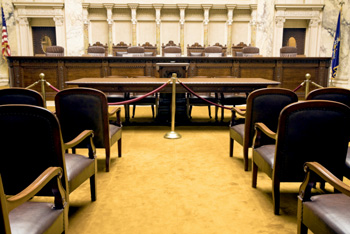 April 7, 2014 – A Wisconsin Supreme Court majority (4-3) at its recent open administrative conference last week did not approve a petition, submitted by the State Bar of Wisconsin, to extend dues relief to younger lawyers and change the dues structure for lawyers who practice law into their 70s.
April 7, 2014 – A Wisconsin Supreme Court majority (4-3) at its recent open administrative conference last week did not approve a petition, submitted by the State Bar of Wisconsin, to extend dues relief to younger lawyers and change the dues structure for lawyers who practice law into their 70s.
The State Bar can resubmit the petition (13-09) to address the concerns raised by one or more of the majority of justices who did not approve the petition in its current form.
Currently, young lawyers pay half State Bar dues (currently $112) and assessments (currently $83) in their first three years. The proposal extended dues relief to lawyers in their first five years, including a 50 percent break on court assessments.
The petition also creates a new dues structure for emeritus lawyers.
Currently, members can elect “emeritus” status at age 70 and stop paying dues, even if they are still practicing law. The proposal requires lawyers to keep paying dues until the age of 75, with dues amounts based on the number of hours (or equivalent) billed.
An objector, Steven Levine, filed a brief opposing the emeritus dues structure changes as unworkable, and rejected the notion that all new lawyers should get a dues break.
Justices Michael Gableman, David Prosser, and Patience Roggensack supported the petition, submitted by the State Bar in July 2013. Chief Justice Shirley Abrahamson, and Justices Ann Walsh Bradley, Annette Ziegler, and Patrick Crooks did not support the petition as currently drafted, but left room for changes and resubmission.
The chief justice said it seemed “unnecessarily complicated to add categories and deal with billable hours” when it comes to emeritus lawyers, and suggested that a financial break should be targeted to those younger lawyers who need it, not all of them.
In December 2012, the State Bar’s 52-member Board of Governors (board) voted to extend State Bar dues relief to young lawyers in their first five years. The proposal recognized the increased financial burdens on today’s young lawyers.
With support from the Senior Lawyers Division, the board also voted to support the dues structure change for emeritus lawyers, recognizing that more lawyers practice law well into their 70s while continuing to benefit from State Bar membership.
Members of the State Bar’s Emeritus Dues Structure Committee, created by Past-President Kevin Klein, vetted the proposal with input from the Senior Lawyers Division.
Succession and Removal Petition
The court partially rejected another State Bar petition (13-07) to implement removal provisions relating to State Bar board members (governors) and officers. However, the court adopted the State Bar’s proposal for new procedures to fill vacant board seats.
The State Bar is governed by a 52-member board, which represents the interests of district constituents, and its executive officers, including State Bar president. Currently, there is no mechanism for governors or officers to be removed from office.
In June 2013, the board voted 34-3 to approve a State Bar bylaw allowing the removal of officers or governors who are unable or unwilling to fulfill their duties.
The bylaw also allowed removal for actions “contrary to the best interest of the State Bar as determined by an affirmative vote of 75 percent” of the 52-member board.
The petition requested supreme court rules to implement the removal process according to the State Bar bylaws, which also established a mechanism to fill vacant seats.
A group of member respondents challenged implementation of the removal bylaw, arguing that it offended free speech protections, among other concerns.
Current State Bar President Patrick J. Fiedler noted that the proposal was not intended to stifle speech, but to create a framework of good governance that addresses misconduct viewed as detrimental to the bar and the legal profession.
Several justices recognized a removal provision as good governance, but voiced concern that a provision allowing removal for actions “contrary to the best interest of the State Bar” was overboard and ambiguous. The State Bar may redraft and resubmit.
Other state bars have removal provisions to deal with misconduct while in office, according to the State Bar’s petition, which notes a circumstance involving the sitting treasurer of the Minnesota State Bar who was convicted on sexual assault charges. At the time, the Minnesota State Bar had no mechanism in place to remove him.
The State Bar’s supporting document notes other circumstances of misconduct in other states. No such circumstance has occurred in Wisconsin, but there should be a mechanism in place, the State Bar asserts, to address any future situation.
